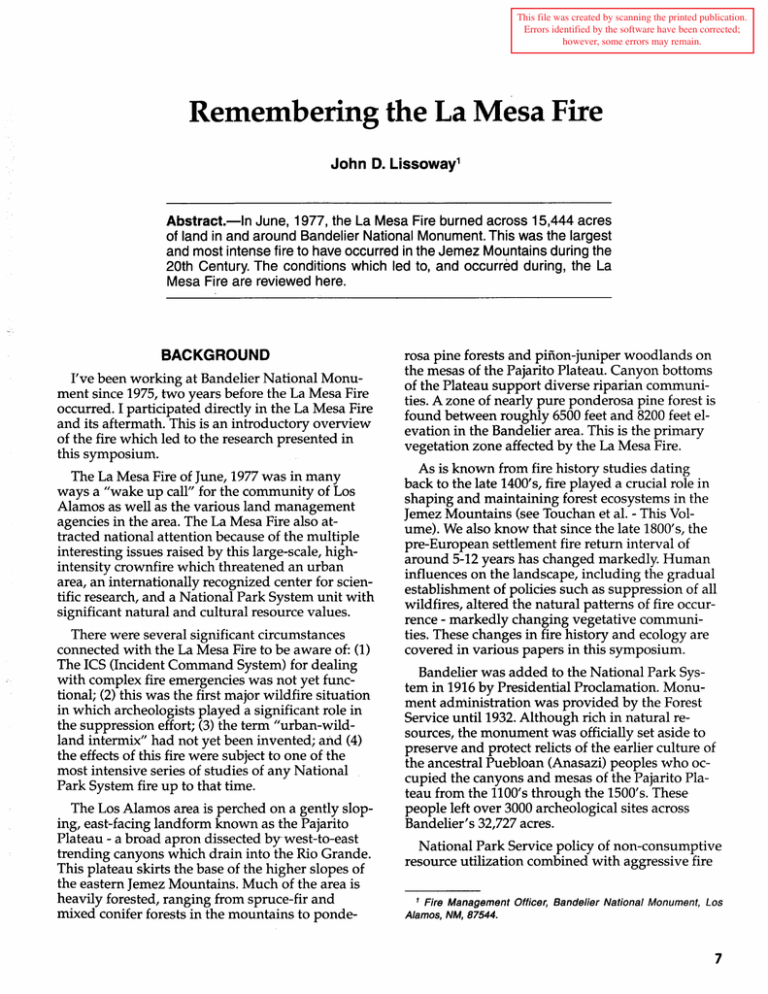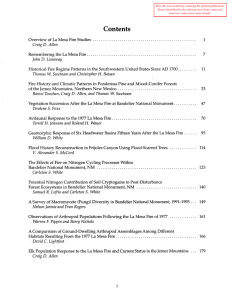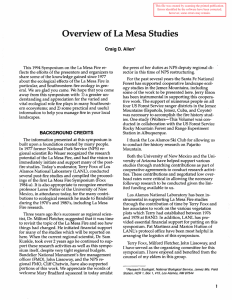Remembering the La Mesa Fire Lissoway1 John
advertisement

This file was created by scanning the printed publication. Errors identified by the software have been corrected; however, some errors may remain. Remembering the La Mesa Fire John D. Lissoway1 Abstract.-In June, 1977, the La Mesa Fire burned across 15,444 acres of land in and around Bandelier National Monument. This w~s the ~argest and most intense fire to h?ve occurred in the Jemez Mo~ntaln~ dUring the 20th Century. The conditions which led to, and occurred dUring, the La Mesa Fire are reviewed here. BACKGROUND I've been working at Bandelier National Monument since 1975, two years before the La Mesa Fi~e occurred. I participated directly in the La Mesa ~Ire and its aftermath. This is an introductory overvIew of the fire which led to the research presented in this symposium. The La Mesa Fire of June, 1977 was in many ways a "wake up call" for the community of Los Alamos as well as the various land management agencies in the area. The La Mesa Fire also at-. tracted national attention because of the multIple interesting issues raised by this large-scale, highintensity crownfire which thre~tened an urban. area, an internationally recognIzed center for .sCl~n­ tific research, and a National Park System unIt wIth significant natural and cultural resource values. There were several significant circumstances connected with the La Mesa Fire to be aware of: (1) The ICS (Incident Command System) for dealing with complex fire emergencies. was ?ot.yet ~unc: tional; (2) this was the first major wIldfIre sItuatIon in which archeologists played a significant role in the suppression effort; (3) the term "urban-wildland intermix" had not yet been invented; and (4) the effects of this fire were subject to one of the most intensive series of studies of any National Park System fire up to that time. The Los Alamos area is perched on a gently sloping, east-facing landform known as the Pajarito Plateau - a broad apron dissected bywest-to-east trending canyons which drain into the Rio Grande. This plateau skirts the base of the higher slopes of the eastern Jemez Mountains. Much of the area is heavily forested, ranging from spruce-fir and mixed conifer forests in the mountains to ponde- rosa pine forests and pinon-juniper woodlands on the mesas of the Pajarito Plateau. Canyon bottoms of the Plateau support diverse riparian ~ommuni~ ties. A zone of nearly pure ponderosa pIne forest IS found between roughly 6500 feet and 8200 feet elevation in the Bandelier area. This is the primary vegetation zone affected by the La Mesa Fire. As is known from fire history studies dating back to the late 1400's, fire played a crucial role in shaping and maintaining forest ecosyste~s in the Jemez Mountains (see Touchan et al. - ThIS Volume). We also know that since the late 1800's, the pre-European settlement fire return interval of around 5-12 years has changed markedly. Human influences on the landscape, including the gradual establishment of policies such as suppression of all wildfires, altered the natural patterns of fire occurrence - markedly changing vegetative communities. These changes in fire history and ecology are covered in various papers in this symposium. Bandelier was added to the National Park System in 1916 by Presidential Proclamation. Monument administration was provided by the Forest Service until 1932. Although rich in natural resources, the monument was officially set aside to preserve and protect relicts of the earlier culture of the ancestral Puebloan (Anasazi) peoples who occupied the canyons and mesas of the Pajarito Plateau from the 1100's through the 1500's. These people left over 3000 archeological sites across Bandelier's 32,727 acres. National Park Service policy of non-consumptive resource utilization combined with aggressive fire 1 Fire Management Officer, Bandelier National Monument, Los Alamos, NM, 87544. 7 suppression had its own unique impacts in many park units: Bandelier was no exception. By the mid-1970's, it was becoming rather disturbingly clear to Bandelier's management that much of this dense and stagnating forested area within the park was viewed at high risk for what many fire people call a real "ripper" . PRELUDE TO THE FIRE Prior to the La Mesa Fire, the effects of fire suppression practices on Bandelier's resources were just beginning to be documented by researchers such as Dr. Loren Potter of the University of New Mexico and Teralene Foxx, a local plant taxonomist. Within the pre-La Mesa landscape, forest density often exceeded 2,000 stems per acre of evenaged and stagnating mature trees. This in-turn produced a canopy cover estimated in the 80-100% range - suitable for a stand-destroying crownfire under the right conditions. Other obvious effects of fire suppression included lack of herbaceous understory and an expanding infestation of dwarf mistletoe in the largely ponderosa pine overstory. Annual precipitation at the Bandelier Fire Tower (6500 ft. elevation) averages about 16.5 inches, largely derived from summer rainfall and winter snowfall. A poor snowpack from November 1976 through April 1977, yielding under 5 inches of total precipitation, provided for increasing drought-like conditions. The precipitation in May, combined with the first two weeks of June, added to a scant 0.64 inches. Fuel moistures for the over 3-inch diameter dead and down materials, an indicator of long-term drought, declined rather sharply from 15% on May 1 of 1977 to 6% (extremely volatile) on June 16. The afternoon, average, minimum relative humidity measured at the Bandelier Lookout dropped one week before the fire from 17% to 5%. The average high temperature for June that year was 88 degrees F, about 6 degrees above normal for the month. The burning index, or "B!", represents one of many predictive fire danger parameters, and gives the fire program manager a good idea of how to preplan initial attack resources. The BI is computed daily from weather observations to characterize the potential behavior of the "intiating f~re". This number, after specifying inputs such as fuel moistures, humidity, wind and other factors, can predict flame-lengths at the fire's leading edge. In other words, a normal BI for this time of the season might be in the neighborhood of 35, which tells fire 8 people that flame length in the fuel type of concern will be about 3.5 feet. A BI of 40 is 4 feet, and so on. Fire managers generally consider flame lengths of over 4 feet to be the upper limit of human direct attack on the fire's edge with handtools. The conditions for June of 1977 looked grim. The average BI for the month of May was 58, already in the zone of high escape potential for initial attack forces in the daytime. On the 15th of June, the BI from afternoon weather observations was calculated at 92. THE FIRE At approximately 3:55 P.M. on June 16, 1977 under a cloudless sky, a USFS contract helicopter with helitack crew (based near Jemez Springs) responded to a smoke report on Mesa del Rito on the Jemez District of the Santa Fe National Forest, just west of the park boundary. It became clear to many that afternoon that nature's ''balloon payment" in this severely altered, drought-impacted forest was about to come due. Bandelier's engine crew responded immediately. Other engines and crews were also rolling. By 5:30 P.M., according to the aerial recon observer, the fire was now estimated at over 50 acres. By 6:00 P.M., fire size was estimated at 100 acres with average rates of spread later calculated at over 24 feet/ minute. By nightfall on the 16th, the fire had dropped into the narrow and heavily wooded upper Alamo Canyon. To avoid the extreme potential for firefighter entrapment, the decision was made not to send people down into that canyon during the night. On the 17th, humidities were hovering at 5%, temperatures during the day in the low 90's and winds were southwesterly at 15-18, gusting to 35 at treetop level. These conditions led to a major fire run up and out of Alamo Canyon, with long-range spotting, intermittent to sustained crowning (where fire leaves the surface and spreads most rapidly through the treetops), and a well organized convection column which lofted heat and fire brands to well over 20,000 feet. Spread was primarily to the northwest, approaching the rim of Frijoles Canyon. By late afternoon, a spotfire estimated at over 20 acres on the north rim of Frijoles was confirmed. The main fire's estimated size at this time was 2,000+ acres. A Class I fire management team was ordered along with a full complement of support resources, crews, engines, helicopters, and overhead. Park management was also making campaign plans. The Bandelier backcountry was evacuated and the park was ordered closed as of June 18. Late on the 18th a Class I team from California assumed management of the fire from the local Fire Boss, Orlando Romero of the Santa Fe National Forest. A dozer fireline was completed across Escobas Mesa from near the Ponderosa Campground, and engines were positioned defensively along this planned control line. However, nature had other ideas for the overhead team. By the start of what is termed by fire people as the daily ''burning period" (approximately 10 A.M.), the winds had increased to 20-30 mph from the southwest, the relative humidity dropped to 3%, and estimated rates of spread were approaching 38 chains/ hour (1 chain=66 feet). These conditions gave rise to one of the most spectacular high-intensity, sustained, crown-fire runs in recent history for the region. With flame lengths often exceeding 200 feet through these dense, dog-hair thickets, engine crews working along the two dozer blade-wide fireline quickly cut their hoses and rolled out to escape this unstoppable fire. They left in their wake a mile-plus wide fire front heading towards State Route 4 and Los Alamos Scientific (now National) Laboratory lands beyond. This fire was now consuming everything combustible in its path, often down to bare mineral soil. By 12:30 P.M. that afternoon, the fire had reached Highway 4 east of Bandelier's Ponderosa Campground after nearly entrapping several engine and handcrews. Spotting distances during the day were estimated at 1/2 to 2 miles, with total fire size at this time estimated to exceed 5,000 acres. Structural fire apparatus crews from Los Alamos hastily retreated north into Laboratory technical area sites to deal with numerous spotfires. Management of the fire had reached another dimension now, with a third agency becoming involved in the incident. As the fire moved from heavily forested fuels into more open and discontinuous fuels, combined with dissipating late afternoon winds, the fire's intensity decreased in the Laboratory area. On June 19th the fire weather forecast called for another day of extreme spread rates through ponderosa pine forests, with spotting, crownfire behavior, and 25,000 ft. convection column development predicted. By mid-morning however, handline was completed along the western boundary of the fire, with engine crews burning out westerly along Highway 4 from Backgate to the Los AlamosSandoval County line. Good progress was also being reported along the southern and eastern portions of the fire's perimeter. Archaeologists were a familiar site on the fire now - leading equipment, marking sites or features to be avoided, and talking to fire crews tempted to collect souvenirs. On the 20th of June, the first significant weather break was indicated in the forecast. Although winds were continued high with low humidities during the day, the night shift called for possible thunderstorms with much higher humidities. This proved to be the first major break for crews in making progress toward containment. On the 21st, there was a heavy cumulus cloud buildup with late afternoon humidities building to around 70%. The estimated burned area was up to 11,000 acres, with a fire perimeter of nearly 18 miles. The now weary management team, along with the l,OOO-plus "ground pounders", could finally catch a glimmer of hope. On June 22 at 4:00 P.M., six long days and nights after the initial smoke report and action, the fire was declared contained. This meant that a fireline had been established completely around the fire. Full control of this fire would not come for another 3 days. In all, 1370 personnel, 9 dozers, 23 engines,S air tankers, and 5 helicopters were committed to this incident. There was one fatality. Long-time Bandelier employee Johnny Aldaz died of a heart attack on June 18 while assigned to an engine crew. His memorial is located near the Bandelier Entrance Station. THE AFTERMATH The final acreage for the La Mesa Fire was set at 15,444, with over 10,230 on National Park Service, 2,684 on Santa Fe National Forest, and the remaining 2,530 on Los Alamos National Laboratory lands. This was the largest and most intense fire to have burned in the Jemez Mountains since the late 1800's. Total cost to the taxpayers of the La Mesa Fire was approximately 3 million dollars, or roughly $190 per acre. The average cost of fire suppression has now climbed to well over $600 per acre. Impacts resulting from the fire's intensity and duration on vegetation, wildlife habitat, watersheds and soils, riparian systems, aesthetics, and non-renewable cultural resources ranged from 9 minimum to very severe. For the intensely burned areas, a rehabilitation plan was prepared. Among the first of this kind in the National Park System, the priorities were: (1) to immediately stabilize the bare soils, handlines and dozer lines (remembering that onset of the summer monsoons was only days away); (2) to assess the extent of damage to cultural resources, from both direct fire effects and human suppression activities; and (3) clear visitor use trails, bridges, damaged facilities and cleanup debris. To accomplish these priority tasks the Park Service, in cooperation with the Santa Fe National Forest, reseeded all but some 2,000 acres of burned 10 area on lands managed by Los Alamos National Laboratory. Archaeologists from the NPS Regional Office in Santa Fe conducted a fire effects study on cultural sites and materials, and developed perhaps the first study-based recommendations for managing wildland fire on a cultural landscape (see Cartledge - This Volume). National Park Service Regional Chief Scientist Roland Wauer at that time had a notion of the enormous scientific study potential contained on the mesas and in the canyons of the La Mesa Fire area. He and his staff were instrumental in organizing and securing funding for a variety of ensuing research studies. This symposium presents followup results, as well as new studies, on the enduring effects of the La Mesa Fire.



